Booty and the Beasts
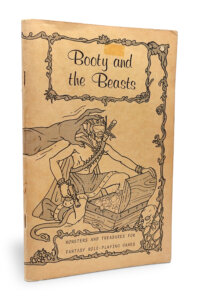
Back in 1979, Dungeons & Dragons was still a growing phenomenon. To be fair, no one had seen anything quite like it before. And, while early D&D eventually boasted its own official supplements, as well as a handful of imitators, the early gaming market was pretty sparse compared to today’s. But the creative spirit of roleplaying games was very much alive in 1979. In the absence of “official” releases, diehard fans simply made their own books. The best of these works, unfettered by established boundaries or industry standards, were gloriously, bizarrely imaginative efforts of do-it-yourself creativity. Exhibit A: Booty and the Beasts.
Booty and the Beasts, published in 1979 by Fantasy Art Enterprises is certainly an interesting book. Coming just five years after D&D was first published, this book is definitely a bit of gaming history. It’s a collectible treasure and an interesting look at early RPG design and aesthetics.
It’s also really, really weird.
The Art and the Artist
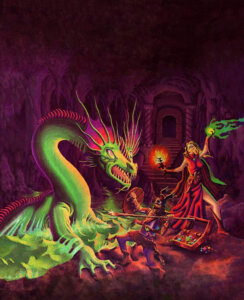
The first thing that makes Booty and the Beasts stand out is its art. The main illustrator here is Erol Otus, who did quite a bit of work for early TSR. Perhaps most famously, Otus painted the cover of the Basic and Expert D&D sets. Those are the rules that brought thousands of 80s kids into the D&D hobby. If you’ve seen Stranger Things, that’s one of versions of basic D&D that Mike and his friends were playing.
Erol Otus’ art is a big part of what gives Booty and the Beasts its unique look. Part Dr. Suess, part underground comic books, Otus’ illustrations have personality. In contrast to the technically polished RPG that would follow, there’s something lo-fi and punk rock about these illustrations. It’s an aesthetic that perfectly matches the homebrew feel of early fantasy roleplaying games.
What’s inside Booty and the Beasts?
From the foreword of Booty and the Beasts:
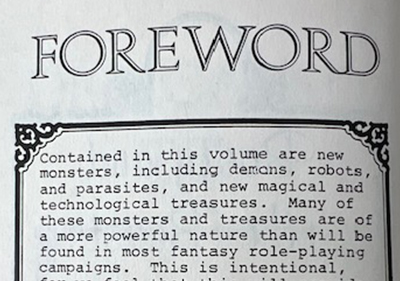
The book contains new monsters and treasures. Booty and beasts, as it were. And not just new monsters, but new demons, robots, and parasites. Those are weirdly specific categories, but I’ll take the author’s word for it. Also, while the text doesn’t mention a system, a deeper look clearly shows the book’s Original D&D influences. Terms like hit points and armor class abound. Damage is expressed as a range instead of dice, so “3-18” instead of “3d6”. All of which marks this as an OD&D product in all but name.
Mingo Snail
Our first monster…er…beast is a selection from the Aquatic section of the book: the Mingo snail.
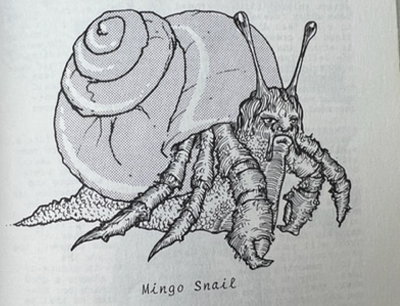
Look at this grumpy dude! He’s a giant snail with a human face, and he’s not happy about it! I find this drawing off-putting in a way I can’t place. Maybe it’s because, in Erol Otus’ imagination, snails are kind of hairy. Wait, hairy snails? Why, Erol, why?
According to the text, the Mingo Snail is an underwater scavenger. However, this is still a D&D monster, and that means it needs some kind of attack! And the Mingo snail does not disappoint. According to the text, a Mingo Snail’s bite “injects a poison that causes the victim to throw up his entrails and lose his eyeballs, which fall out onto the ground.”
It does what now?
The vomiting up your own insides is one thing. But why oh why do your eyes fall out? I looked further into the description and learned a little more. To quote:
“…the monster will also attack to save its good friends, the Oyster People, from harm, for Mingo Snails are in desperate need of psychoanalysis and only the Oyster People can provide this service.”
“In desperate need of psychoanalysis” is not a phrase I ever thought I’d see in a D&D monster book. On the other hand, after an eye-popping gut-spewing encounter with a mustachioed snail, I think I’d be in desperate need of some kind of assistance myself.
PIRAHNA DEMON
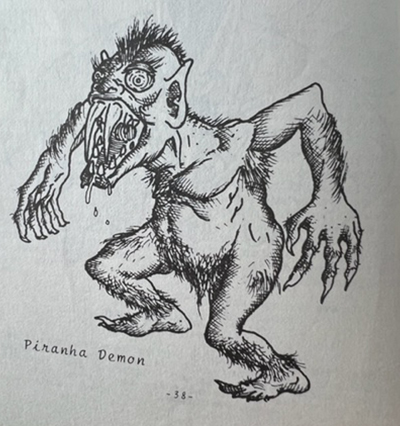
The Piranha Demon comes, appropriately enough, from the Demons section of the book. His name pretty much says it all: he’s a demon who eats stuff. According to the book, a Piranha Demon must consume 10 times its own weight every day to survive. That’s not an issue, though, as these demons are really good at eating. They can eat you whole, digest you, and expel you all in one round.
“……if the Piranha Demon hits his target, he will rend it to pieces, devour, digest and then expel him as waste material, all during his attack.”
That’s pretty gross, but when you have to eat your own weight in food 10 times a day, you can’t afford to be picky. Or to use a napkin. Or wear pants.
Compared to most of the monsters in Booty and the Beasts, a demon that likes to eat people is pretty standard D&D stuff, but I chose this monster for the art. I think the creature is a good example of what Otus can accomplish with just a simple illustration. Sure, this isn’t great technical art, but it carries a strong emotional feel. And just look at how pointy he is! Pointy ears, pointy elbows, and pointy teeth. And check out that drool! And those crazy eyes! If Mad Magazine had a D&D section, the Piranha Demon would feature in it.
A few more…
Here’s an illustration for the Macrosite. One of the aforementioned parasites.
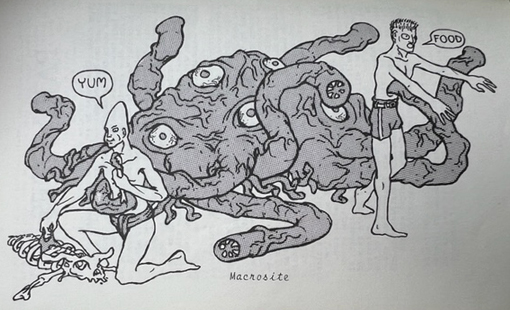
So, it’s definitely getting weirder as we go. The Microsite is the thing in the center, with the tentacles. But what is that pointy-headed fellow eating? And why? Is he being controlled by the pile of ropy eyeballs? Is it making him hungry for some reason? And where’s that dude in the gym shorts headed? This creature is explained in the book but, after analyzing this picture, I don’t actually want to know the answers.
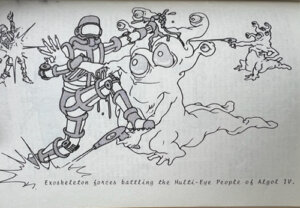
Here’s another illustration with an explanatory caption that doesn’t explain much. It say it’s the “exoskeleton forces battling the multi-eyed people of Algol IV.” Wait, are the multi-eyed people of Algol IV any relation to the monster on the front cover? That tentacled baddie that looks like mix between Cthulhu and Stanley Kowalski? No, that can’t be, as the cover guy has two eyes. If I know anything about the multi-eyed people of Algol IV (and I don’t), then I know they have more than two eyes. It’s right there in the name!
Alas, I see no entry for people of Algol IV in the book, multi-eyed or otherwise. The closest I could come up with was this guy. He’s apparently an Egg Person. And he’s from Venus. That’s his literal name: Egg Person from Venus. I’m calling that good enough.
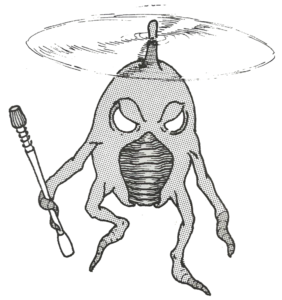
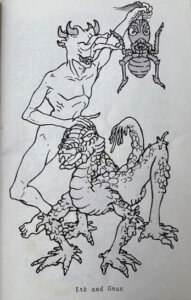
Finally, here are three baddies in one picture.
That’s an Erb and a Grue. And I believe the Erb is holding up a rather bemused-looking Termite Man. Or maybe the Grue is holding the Termite Man. What’s the difference between an Erb and a Grue? And would you fight one in a box? Would you, could you, with a fox?
I think I may be losing my mind.
Final Thoughts
Part of the charm of early D&D is how willing it was to embrace whimsy. By all accounts, puns were a big part of those nascent games back in the 70s. Booty and the Beasts includes them as well. Monsters not pictured above include the Tortilla (a gorilla with a tortoise shell), a half bee / half eagle called a Beegle (get it?), and other silly ideas. Sure, most of these kinds of monsters didn’t pass the test of time. But books like Booty and the Beasts reminds us that, at one point in the hazy 1970s, someone dared to ask “what if we crossed an owl…with a bear?”
Sometimes weird ideas stick.
[ More from Andrew: Adapting Older D&D to Modern Rules ]
[ Browse all Dungeons & Dragons ]
[ Shop all RPGs ]
